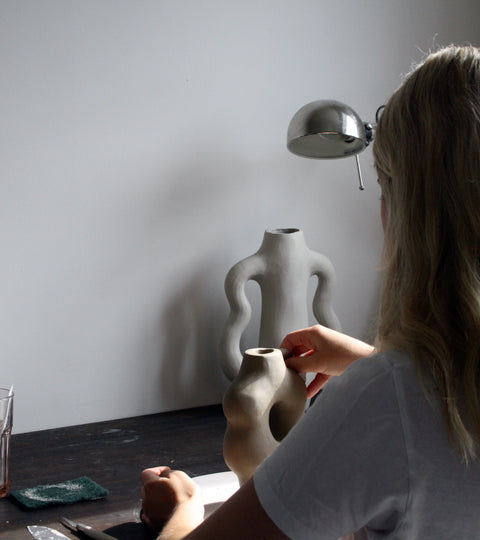Meeting Annabel Cucuz
You studied sculpture, what brought you to the clay material?
I grew up in North Staffordshire in England, which was the heart of Britain’s ceramics industry – there was an abundance of clay and coal here so from the 17th century onwards the area was full of pottery factories. It’s a huge part of the local identity, so I think I’ve always somewhat felt connected to the craft. When the pandemic hit in March 2020 I was working towards my summer degree show at the Edinburgh College of Art, but we were all told to pack up our studios and go home. I was working on large (about 3-metre-tall) metal sculptures at the time, so I had to unexpectedly adapt my practice to suit a home studio with no access to my university workshops. I’d spent a lot of my final year at university making models and maquettes out of modelling clay, so I reverted back to this as a temporary medium, which naturally lead to ceramics. I loved the hands-on approach to making with only simple tools; it makes you feel so connected to the material.

What’s your favorite technique, your favorite tool and what work do you most enjoy doing?
Hand-building is my go-to technique – I coil the clay and then blend with a corrugated metal rib, which is my favourite tool. Either that or my rubber kidney which I use to smooth a finished piece. Hand-building is ideal for creating the shapes that I do; it’d be impossible to create them on a potter’s wheel. It’s a very slow practice, but that’s what I love about it – every day that I’m hand-building in the studio is almost a day of meditation.

Take us through your creative process. What and who inspires you?
My visual research focuses around what I like to call “misplaced nostalgia”, although I often find myself inspired by nearly anything and everything with no research formula being strictly necessary. At university I became obsessed with this idea of time parallels, particularly in a cultural context. I’m interested in how we can watch a film like A Clockwork Orange which is set in the ‘near future’, reflected in not only the sociological themes but also the interior set design of the film - but that aesthetic future somehow did not happen. The film looks forward, but it’s not looking at us. Alison and Peter Smithson designed House of the Future in 1956 which portrayed their idea of a house that would be the norm 25 years later, made completely of plastic. They looked towards the 80s but the 80s didn’t meet their gaze once it came around. This weird disconnect of an imagined aesthetic future and a future that didn’t happen made me want to create work that could exist in this in-between, work that visually could fit anywhere, in any time and in any space. I spend a lot of time watching old television programmes about architecture and interior tastes (a particular favourite is the BBC’s Signs of the Times which aired in the early 1990s), flicking through interior inspiration books and magazines from the 70s, 80s and 90s, and also watching period tv shows like Mad Men and paying attention to their set design. Whether I see a shape that I want to recreate or there’s just a certain feel of a scene that I want to make a piece about, there’s always an abundance of inspiration wherever I look.
I also draw inspiration from modernist sculptors such as Valentine Schlegel, Barbara Hepworth, Isamu Noguchi, Constantin Brancusi, metaphysical and surrealist painters (particularly Giorgio Di Chirico and René Magritte), as well as contemporary artists and designers who create imagined paradisiacal digital scenes such as Charlotte Taylor and Alexis Christodoulou.

Can you tell us a bit more about the pieces selected for Volume Ceramics?
They’re both made from stoneware which is my go-to firing body. I made Toasted Postmodern 1 whilst looking at post-modern interiors and how they’re having quite a renaissance at the moment too. I love how fun a wavy silhouette is. Desert in Black 1 came from more of an improvisational space, but the silhouette that I ended up making had a wild-west feeling, something about it felt cactus-like to me. It evoked thoughts of cowboys, saloons and No Country for Old Men.
Do you listen to music while working? Share with us your playlist at the studio!
Absolutely - my favourite element of what I do is the fact that I can switch off whilst making and listen to music. What playlist I listen to depends on what mood I’m in and what time of year it is – at the moment I’m listening to this one a lot https://open.spotify.com/playlist/0CtOHVIPHj7CXrCYAtyqcy?si=76197ec7d75045d7

What's next for you? What would be your dream project?
I’m currently working on some pieces for our small-scale delayed degree show which is coming up in December, along with an exciting concept store in London which will be happening around the same time. I’m planning on spending some time in Italy next year where I can focus on my work in a new context and be inspired by a new environment, which is definitely going to be a dream project.

